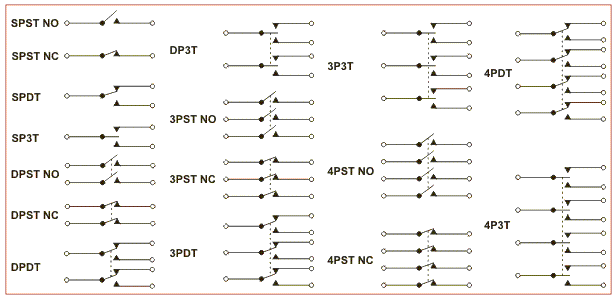Switches are everywhere — from your light switch at home to the buttons on your favorite gadgets. They might look simple, but there’s a wide variety designed for different uses and control needs. Let’s take a look at the most common types of switches and what makes each one unique.
Basic Mechanical Switches
- SPST (Single Pole Single Throw): The simplest type — turns a circuit ON or OFF.
- SPDT (Single Pole Double Throw): Routes current between two outputs; great for selection control.
- DPST (Double Pole Single Throw): Controls two separate circuits with one switch.
- DPDT (Double Pole Double Throw): Can reverse current direction or control two circuits independently.
- Momentary Switch: Active only while pressed — like a doorbell.
- Toggle Switch: Flips between ON and OFF positions using a lever.
- Rocker Switch: Rocks back and forth; often found in power panels.
- Slide Switch: Moves sideways to open or close a circuit.
- Rotary Switch: Rotates to select one of many output positions — perfect for mode selection.

Special Purpose Switches
- Pushbutton (PB) Switch: Activated by pressing; used for temporary or latching control.
- Limit Switch: Triggered by a moving part — commonly used in machinery.
- Micro Switch: Tiny and ultra-responsive; detects slight movements.
- Reed Switch: Operated by a magnetic field — used in sensors and alarms.
- Pressure Switch: Responds to air or fluid pressure changes.
- Float Switch: Detects liquid levels, useful in sump pumps and tanks.
- Thermal Switch: Reacts to heat to protect circuits from overheating.
- Key Switch: Operated by a key for secure access or safety lockout.
Electronic and Sensor-Based Switches
- Relay (Electromagnetic Switch): Uses an electromagnet to control high-power circuits.
- Transistor Switch: A solid-state electronic switch that controls current using voltage.
- Optical Switch: Activated by light; ideal for automation and sensing applications.
- Proximity Switch: Detects nearby objects without touching them.
- Touch Switch: Activated by human touch or a change in capacitance.
Switches are like the language of control in electronics — they tell circuits when to start, stop, or change direction. Whether mechanical or electronic, each type plays a role in turning your ideas into real, working systems.